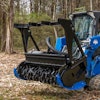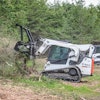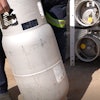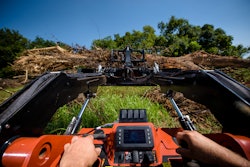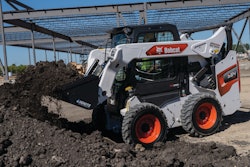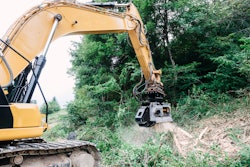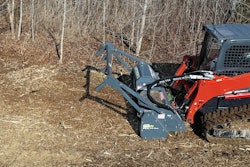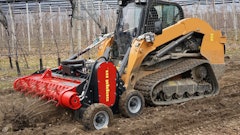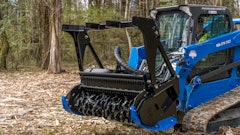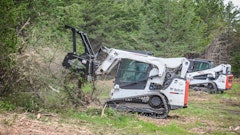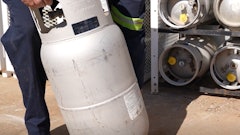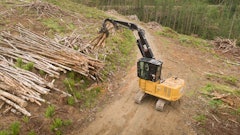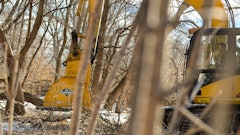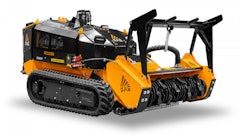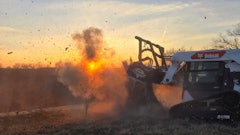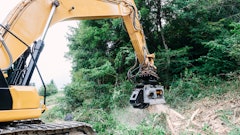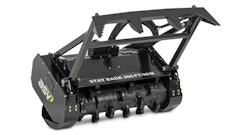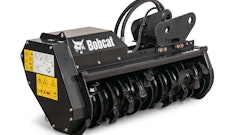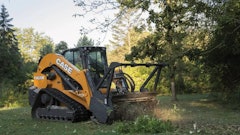
Mulching heads, also known as forestry mulchers or horizontal drum mulchers, have grown in popularity in recent years. However, achieving success with one of these attachments relies not only on the one you choose but also on how you use it. The performance may be disappointing if the attachment isn’t properly suited for the skid steer or excavator on which it will be used. Likewise, production will suffer if the mulcher is operated improperly. Here are some tips on equipment selection and operation to help ensure a good experience.
Selecting for Skid Steers/Track Loaders
When it comes to finding the right mulching head for a skid steer or compact track loader, hydraulic horsepower is much more important than engine power. To determine hydraulic horsepower, simply multiply the gpm and psi of the power unit’s hydraulic system and then divide that number by 1,714. For instance, a track loader with hydraulic ratings of 36 gal per min at 3,450 psi would have a hydraulic horsepower of 72.5 (36 x 3450 / 1714). Use that number to ensure the power unit has adequate hydraulics to run the attachment. 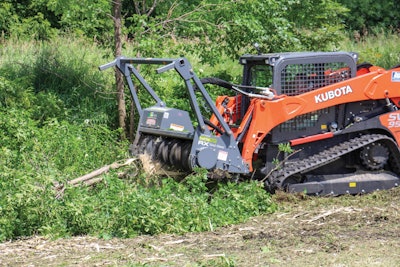 Mulching heads are available for a wide range of skid steers, compact track loaders, and even lower flow models.Loftness
Mulching heads are available for a wide range of skid steers, compact track loaders, and even lower flow models.Loftness
Mulching heads are available for a wide range of skid steers, compact track loaders, and even lower flow models. Keep in mind, however, that performance is directly related to hydraulic power. A skid steer with a higher flow can simply outwork one with a lower flow.
Next, it’s important to ensure that the skid steer or track loader has the weight capacity to carry it. Also, consider the working conditions. Flotation can be an issue with some power units when a heavy mulching head is used on soft ground. The weight and balance of the unit make stability another consideration when operating in rough terrain, steep hills, and valleys.
Equipping an Excavator
When it comes to excavators, mulching heads are categorized according to weight class. One series may be designed for excavators weighing from 10,000 to 20,000 lbs., while the next series will work for excavators ranging from 18,000 to 36,000 lbs. It continues to scale up to accommodate the largest excavators on the market.
After identifying the appropriate excavator weight class, the mulching head needs to be configured correctly for the hydraulic output of the power unit. Some mulcher manufacturers offer different hydraulic motor options to handle various flow ratings, while others have different belt drive configurations. 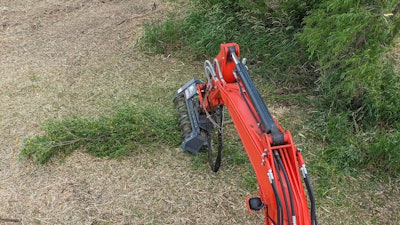 After identifying the appropriate excavator weight class, the mulching head needs to be configured correctly for the hydraulic output of the power unit.Loftness
After identifying the appropriate excavator weight class, the mulching head needs to be configured correctly for the hydraulic output of the power unit.Loftness
Another factor that makes excavator attachment selection different than skid steers is the lack of a universal mounting system. That means the end user needs to work with the equipment dealer to ensure the appropriate mounting style is installed for the type of excavator being used.
Along with the mounting system, a tilting hitch is a strongly recommended accessory when purchasing a mulching head for an excavator, as it will significantly improve the operating experience. As the name suggests, a tilt hitch allows the operator to tilt the mulching head from left to right. 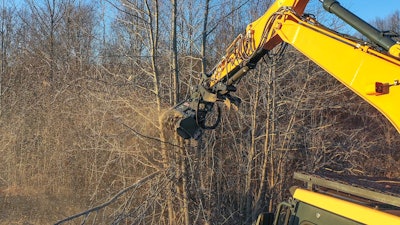 Some mulcher manufacturers offer different hydraulic motor options to handle various flow ratings, while others have different belt drive configurations.Loftness
Some mulcher manufacturers offer different hydraulic motor options to handle various flow ratings, while others have different belt drive configurations.Loftness
Finally, most mulching head manufacturers offer a few options unique to excavators. The first is a spade hook, which is helpful for positioning material to be mulched. A hydraulic thumb can also be added for even better use of the spade hook.
Universal Features
Other important considerations apply to both skid steer and excavator mulchers, including the cutting teeth and rotor options. Many mulching heads can be used with either sharpened knives, beaver teeth, or carbide teeth.
Knives are quite popular on mulching heads since they are capable of cutting finer and faster than other styles. The downside is that knives require regular sharpening, which is a deterrent to some.
Like knives, beaver teeth are made of heat-treated steel, but they do not slice as well. The distinctive pointed shape of beaver teeth helps them pick up material from the ground, despite being less aggressive than knives.
Carbide teeth are a durable, low-maintenance option for less experienced operators. They are often recommended when mulching at ground level in rocky conditions, as they are less prone to damage than knives.
The cutting teeth decision leads to a discussion about the rotor. As sharpened knives have become more popular, so have limiting rotors. Because knives have a natural tendency to bite into material more aggressively than what is ideal, a limiting rotor helps control the material in the feed for more efficient performance. The two main types of limiting rotors available today are ring-style and depth gauges. Ring-style rotors are generally known as having the most restriction. Depth gauges aren’t quite as restrictive, which allows operators to pick up material from the ground more easily, especially when using less aggressive carbide teeth.
Using Your Head
When operating this equipment for the first time, one of the most important pieces of advice is to understand the power unit’s hydraulic capabilities and then stay within that range. Generally, it’s recommended to operate 500 psi underneath the maximum hydraulic relief pressure.
As the load increases, the pressure goes up, and the rotor will slow or even stall when the maximum relief pressure is reached. When this happens, performance is decreased, and heat is generated, which could potentially cause damage to the hydraulic system. To reduce the amount of pressure, operators can simply engage material more slowly.
Mulching heads can be positioned in various ways to accomplish different tasks. This is why operators should really consider tilt hitches for excavator models. For instance, the head can be tilted back to expose the knives to fell standing trees more efficiently.
When mulching material on the ground, it can be helpful to lower the rear of the cutter. This technique can pin material to the ground, so it doesn’t eject out the back of the unit. It can also trap material in the cutting chamber for more thorough processing if desired.
Skid steer operators often use a reverse mulching, or back dragging, technique. Here, the head is tilted forward while the skid steer backs up. This is very effective for sizing material since this action pulls the downed material against the cutter bar and into the chamber. Some units have an adjustable cutter bar to help control particle size and production rate. Some units also have a second cutter bar behind the front bumper, allowing material to be cut twice for more thorough processing. This feature is often referred to as a two-stage cutting chamber.
Like most other things, experience really is the best teacher. Fortunately, there is a lot of demand in right-of-way vegetation management, forestry, land clearing, and other industries to help newcomers gain meaningful experience with mulching heads. This advice, combined with support from your equipment dealer, will help give you a good head start.

